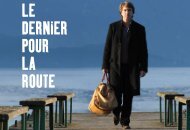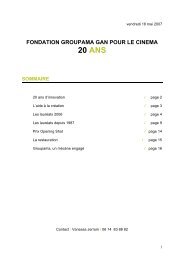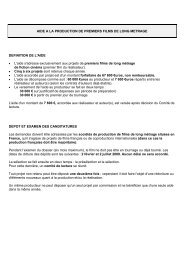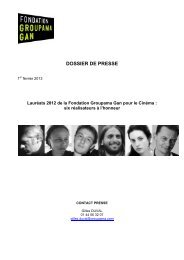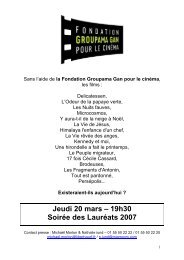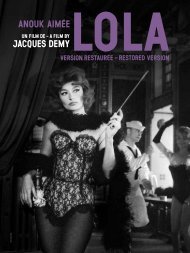Dossier de Presse - Fondation Groupama Gan pour le Cinéma
Dossier de Presse - Fondation Groupama Gan pour le Cinéma
Dossier de Presse - Fondation Groupama Gan pour le Cinéma
- No tags were found...
You also want an ePaper? Increase the reach of your titles
YUMPU automatically turns print PDFs into web optimized ePapers that Google loves.
EXE NOUVELLE VAGUE:EXE LES VACANCES 23/04/09 14:47 Page 49ners how he ma<strong>de</strong> his most recent catch. At the end of theshot, the camera moves down for a closeup of two ridiculouslytiny fish, which discredit the fisherman’s account. It’s the onlyverbal gag in the film, which may explain why he removed itfrom the initial cut.The camera negativeFortunately, the restoration of Mr Hulot’s Holiday was ma<strong>de</strong>possib<strong>le</strong> thanks to the availability of the film’s master e<strong>le</strong>ment:the camera negative. In the wake of the film’s various versionsand the addition of the visual effects, the camera negative –a b<strong>le</strong>nd of mostly nitrate film stock and acetate film stock –endured re-cutting and re-splicing in the course of a creativeprocess covering more than 25 years.Feared because of its highly flammab<strong>le</strong> nature, nitrate filmstock (nitrocellulose) was used from the origins of motionpictures in the late 1890s until the mid 1950s when itstopped being manufactured. Mr Hulot’s Holiday was ma<strong>de</strong>during this historic transitional period. Unfortunately, inFrance, it is against the law to project nitrate film prints butin the United States, a handful of film archives still offer thepossibility of seeing them on the cinema screen.Few peop<strong>le</strong> today can claim to have enjoyed the actual sensoryexperience of a nitrate film print – its singular textureand the warmth of its pictures! Yet apart from its excel<strong>le</strong>ntphysical properties, one of the major qualities of nitrate filmresi<strong>de</strong>s in its photographic capacities, its luminosity and richvisual quality.The restoration: objectives and chal<strong>le</strong>nges• The imageIn or<strong>de</strong>r to protect the camera negative, it was crucial tohave it restored manually by the Preservation Department ofTechnicolor North Hollywood. Their expertise revea<strong>le</strong>d howthe negative was ridd<strong>le</strong>d with splices as well as a multip<strong>le</strong>grading notches on the edges of the film, which ma<strong>de</strong> itdifficult to put it through the printer. To cope with thesetechnical <strong>de</strong>fects, a contact printer was calibrated andadjusted so as to stabilize the image in the gate during itsprinting.The interpositive ma<strong>de</strong>, it was scanned to assemb<strong>le</strong> thecomp<strong>le</strong>te cut of the film with the addition of the openingcredits and the insertion of the final shot, the only colorshot. Documentation and analysis of availab<strong>le</strong> sources showedhow there were different versions possib<strong>le</strong> for this final shot(appearance of stamps and postmarks, one after the other orsimultaneously, montage with or without fa<strong>de</strong> to black). Theaccounts of Pierre Etaix in particular contributed to <strong>de</strong>finingthe appropriate sequence. This e<strong>le</strong>ment was in poor condition,making it impossib<strong>le</strong> to inclu<strong>de</strong> it in the final cut. Only digitaltools allowed us to recreate this shot punctuated by a fa<strong>de</strong>and to reproduce the stamp’s original sheen. All the digitalwork was done and supervised by Tom Burton at TechnicolorDigital Services in Burbank, California, one of the labs capab<strong>le</strong>of carrying out this kind of comp<strong>le</strong>x restoration, equippedas it is with high-performance digital platforms to <strong>de</strong>al withspecific film damage.It was in<strong>de</strong>ed this question of balance between photochemicaland digital procedures that had to be <strong>de</strong>alt with.In the case of Mr Hulot’s Holiday, a major part of the restorationinvolved the improvement or toning down of the transitionsbetween shots. Physically, these transitions are consistent withthe editing splices which, when printed and scanned, sometimescreated distortions in the image or splice bumps. As forthe fa<strong>de</strong>s to black, the digital tool certainly helped improvethe smoothness of these effects which facilitated the narrativeflow of the film.Morever, the restoration of Mr Hulot’s Holiday reconstitutedthe panchromatic harmony of the colors of summer.The nitrate base of the picture negative played a dominantro<strong>le</strong> in preserving the original tones of the black and whitemovie. The grading by Tim Pee<strong>le</strong>r, a master in matters of blackand white movies, allowed us to restore the rich range ofgrays that illuminate Mr Hulot’s summer days at the seasi<strong>de</strong>.• The soundThe restoration of the soundtrack allowed us to bring backthe entire sound range and rhythmic accents of Mr Hulot’sHoliday. Early in 1953, Tati began the sound editing of his filmwhose effects would become inseparab<strong>le</strong> from his picturesque49



